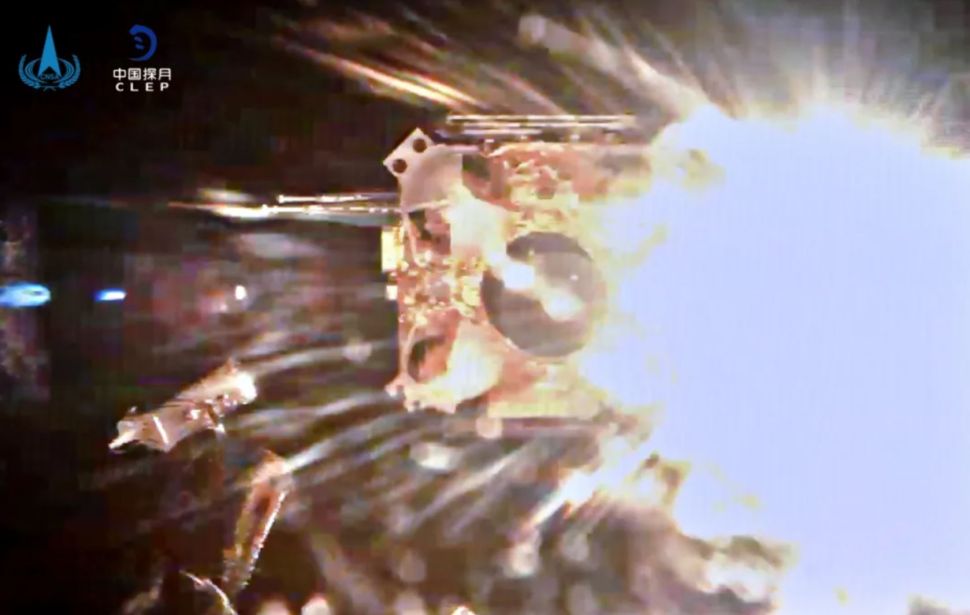
For SpaceUpClose.com & RocketSTEM
CAPE CANAVERAL, FL – After an action packed 19 hours of intense precision work to successfully gather and store pristine samples of lunar soil and rocks yesterday, the ascent vehicle component of China’s bold and ambitious Change’5 moon probe blasted off today, Dec. 3, from Earths nearest neighbor to meet up with the orbiting return capsule and complete the first lunar sample return mission in over 4 decades – and the first ever for China.
“A Chinese spacecraft carrying the country’s first lunar samples blasted off from the moon at 10:10 a.m. EST, 15:10 GMT, 11:10 p.m. Beijing Time) on Thursday, Dec. 3, the China National Space Administration (CNSA) announced today.
“It represented the first-ever Chinese spacecraft to take off from an extraterrestrial body.”
After gathering the lunar surface samples they were sealed in a container stowed aboard the ascent vehicle spacecraft component of the Change’5 moon probe, situated atop the lander component.
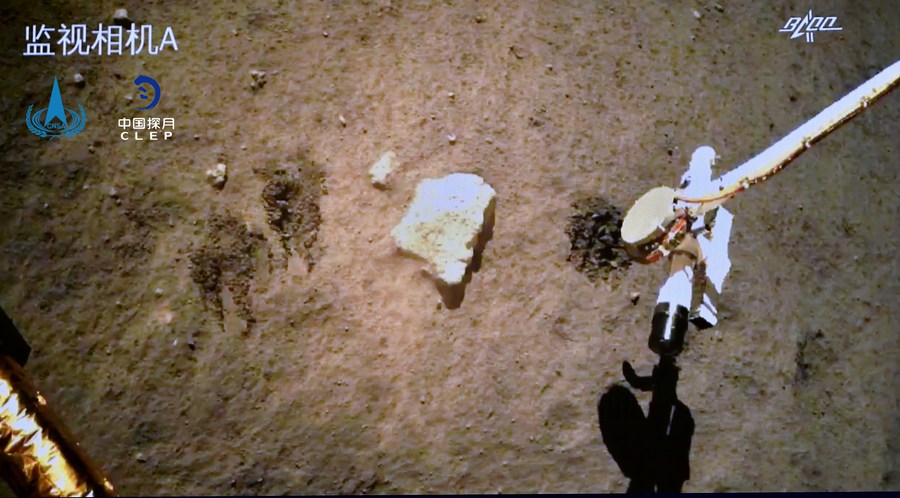
“After the samples were collected and sealed, the ascender of Chang’e-5 took off from the lunar surface,” reported China’s official Xinhua news agency.
Watch this video of the blastoff from Xinhua:
China's #ChangE5 spacecraft, carrying the country's first lunar samples, blasted off from the moon late Thursday. #LunarProbe pic.twitter.com/9N1RH6QQup
— China Xinhua News (@XHNews) December 3, 2020
Using an onboard drill, scoop and robotic arm the solar powered robotic explorer ascender-lander component of Change’5 set to work over two days on the most challenging aspect of the mission – to collect around 2 kilograms or more of lunar dust soil and rock regolith at the landing site in a region to the north of Mons Rümker, a mountain overlooking a vast lunar mare called Oceanus Procellarum, or the Ocean of Storms, on a smooth volcanic plane on the western edge of the moon’s near side.
The goal is to return the cache of precious samples from a depth of up to 2 meters to eagerly awaiting researchers on Earth for detailed scientific analysis.
Photos released by CNSA showed the lunar surface had been dig into by the landers scoop and drill.
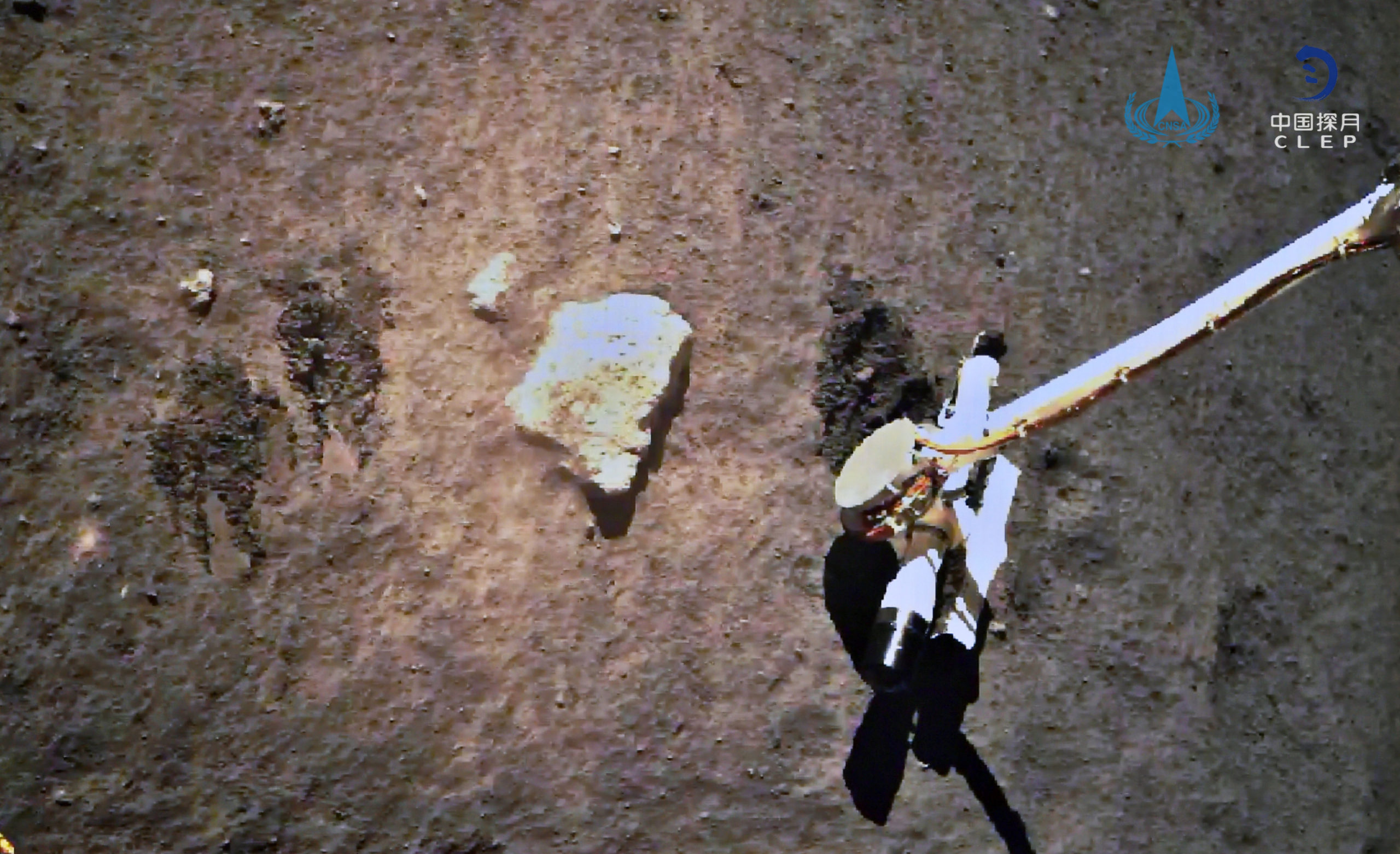
“It adopted two methods of moon sampling, including using drills to collect subsurface samples and grabbing samples on the surface with a robotic arm. It gathered diverse samples at different sites,” said CNSA.
China's Chang'e-5 probe completes sampling on the moon. It has adopted two methods, including using drills to collect subsurface samples and grabbing samples on the surface with a robotic arm. Diverse samples have been gathered. #LunarProbe #ChangE5 https://t.co/9LxFporp3e pic.twitter.com/N4snzNs77Q
— China Xinhua News (@XHNews) December 3, 2020
China is only the 3rd country to attempt a lunar sample return mission – following the United States and the then Soviet Union – now Russia, from Apollo manned and Luna unmanned missions in the 1960s and 1970s.
The Chang’e-5 mission is comprised of four components: an orbiter, a lander, an ascender, and an Earth return capsule.
The precision guided rocket assisted lunar touchdown of the Chang’e-5 lander-ascender spacecraft combination occurred as planned at 10:11 a.m. EST (1511 GMT) 11:11 p.m . Beijing time Tuesday, Dec. 1, on the Mons Rümker region of Oceanus Procellarum or the Ocean of Storms, on a smooth volcanic plane, according to CNSA.
During the landing process, the cameras aboard the lander took images of the landing area.
Several hours post touchdown the lander transmitted a beautiful panoramic image from the lunar landing site on the surface from the Mons Rümker region of Oceanus Procellarum or the Ocean of Storms. See the image below.
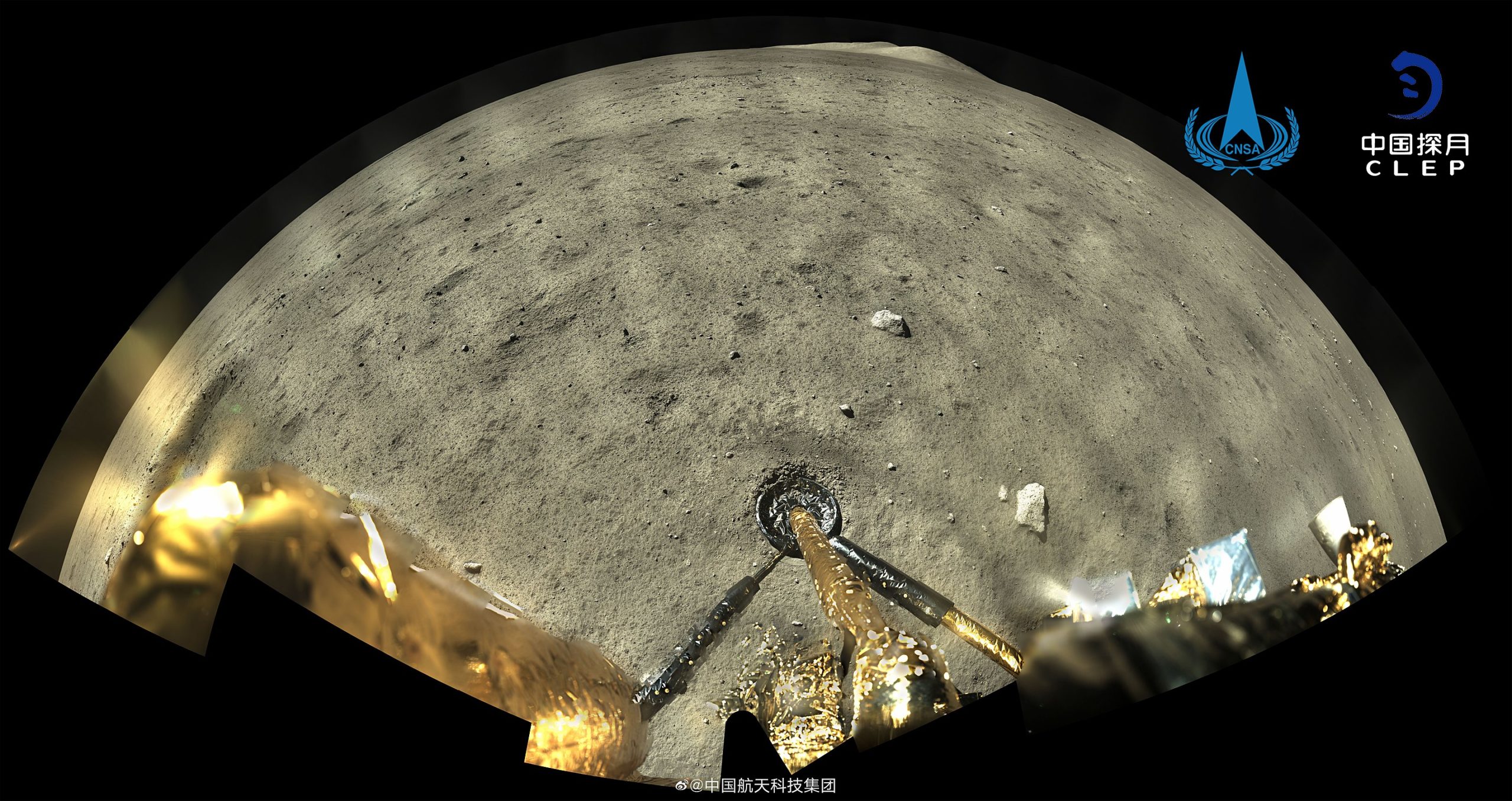
This Xinhua news agency also distributed this dramatic video showing the descent and landing:
First-person view: China's #ChangE5 probe touching down on the moon. The spacecraft successfully landed on the near side of the moon late Tuesday and sent back images. #exclusive pic.twitter.com/A86WxW5c0l
— China Xinhua News (@XHNews) December 2, 2020
Upon completion of surface operations the ascender spacecraft was commanded by Beijing mission controllers to take off and and rendezvous and dock with the orbiter circling overhead in lunar orbit.
“An engine, after working for about six minutes, pushed the ascender to preset lunar orbit,” said Xing Zhuoyi, a designer of the Chang’e-5 probe from the China Academy of Space Technology (CAST) under the China Aerospace Science and Technology Corporation, to Xinhua.
“Different from the ground takeoff, the ascender could not rely on a launch tower system. The lander acted as a temporary “launching pad,” which had touched down on the lunar surface quite stably, Xing said.
“The lunar liftoff conquered many challenges, including limited diversion space for the engine plume and different environments between Earth and the moon,” he said.
“Without any navigation constellation around the moon, the ascender used its own special sensors to conduct self-positioning and attitude determination after the takeoff, assisted by the ground monitoring and control system,” Xing said.
The samples collected could be the youngest samples retrieved from the Moon so far dating to roughly 1 billion years vs 3.1 to 4.4 billion years old for the Apollo samples.
The most recent lunar sample return mission was accomplished by the Luna 24 spacecraft launched by the then Soviet Union in 1976.
To date lunar soil and rock samples were collected and returned from 6 NASA Apollo manned moon landings and 3 Russian Luna robotic missions
Chang’e 5 is equipped with a robotic arm with a sampling scoop, a coring drill, and a sample chamber that can return up to 4 kg of regolith. It also has a Panoramic Camera (PCAM), Lunar Regolith Penetrating Radar (LRPR), and a visible and near-infrared Lunar Mineralogical Spectrometer (LMS).
The Change’5 mission began on Nov. 23 when the Long March 5 rocket successfully hurled the 8200 kg Change’5 moon mission on a fast paced 23 day long mission on China’s first ever mission to snatch lunar regolith from the Moon’s surface and send it back to eagerly awaiting scientists back on Earth landing in Inner Mongolia, China.
The Long March 5 carrier rocket lifted off at 3:30 p.m. EST (2030 GMT) Monday, Nov 23 (4:30 a.m. Nov. 24 Beijing Time) from the Wenchang Space Launch Center on Hainan Island, China on behalf of the Chinese National Space Administration (CNSA).
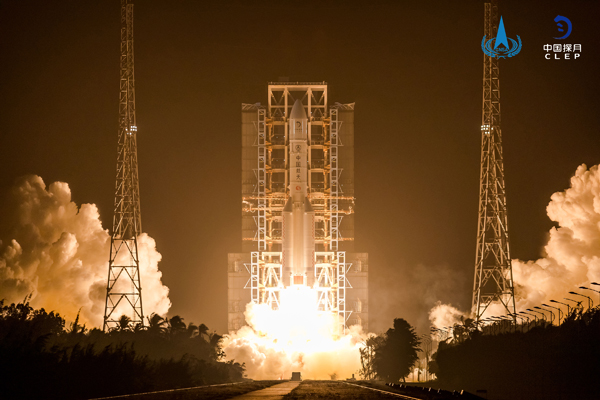
Chang’e-5 marks the next bold step in China three step lunar ambitions following on the Change’ 1 and 2 lunar orbiters and Change’ 3 and 4 landers and Yutu rovers on both the near and far side.
China became the first nation in history to land a robotic spacecraft on the far side of Earth’s Moon, when their robotic spacecraft named Chang’e 4 accomplished a soft touchdown Jan. 3, 2019 with the Yutu-2 moon rover.
The mosaic below by Ken Kremer and Marco Di Lorenzo shows the Yutu-1 moon rover at work on the lunar surface.

Earlier this year China has successfully launched its first fully indigenous mission to Mars – the extremely ambitious Tianwen-1 robotic mission designed to orbit, land and rove on the Red Planet – aimed at comprehensively investigating its climate, atmosphere and geology and search for signatures of water as well as snapping numerous images.
China utilized its most powerful rocket – the relatively new heavy-lift Long March 5 – to hurl the combination Tianwen-1 orbiter and lander mission to Mars.
The Chinese Tianwen-1 spacecraft lifted off atop the Long March 5 carrier rocket from the seaside Wenchang Space Launch Center in southern China’s Hainan province on July 23, at 12:41 a.m. EDT (0441 GMT; 12:41 p.m. Beijing time).
China eventually hopes to land the first Chinese people on the Moon at some point during the 2020s.
NASA seeks to return astronauts to the lunar surface under Project Artemis aiming to land the first woman and next man at the Moon’s South Pole by 2024.
Watch Ken’s continuing reports about SpaceX Crew Dragon, Starlink, Commercial Crew and Artemis and onsite for live reporting of upcoming and recent SpaceX and ULA launches including Demo-2, Starlink, X-37B, Solar Orbiter, Mars 2020 and more at the Kennedy Space Center and Cape Canaveral Space Force Station.
Stay tuned here for Ken’s continuing Earth and Planetary science and human spaceflight news: www.kenkremer.com –www.spaceupclose.com – twitter @ken_kremer – email: ken at kenkremer.com
Dr. Kremer is a research scientist and journalist based in the KSC area, active in outreach and interviewed regularly on TV and radio about space topics.
………….
Ken’s photos are for sale and he is available for lectures and outreach events
Please consider supporting Ken’s work by donating at Patreon:
https://www.patreon.com/kenkremer

x



